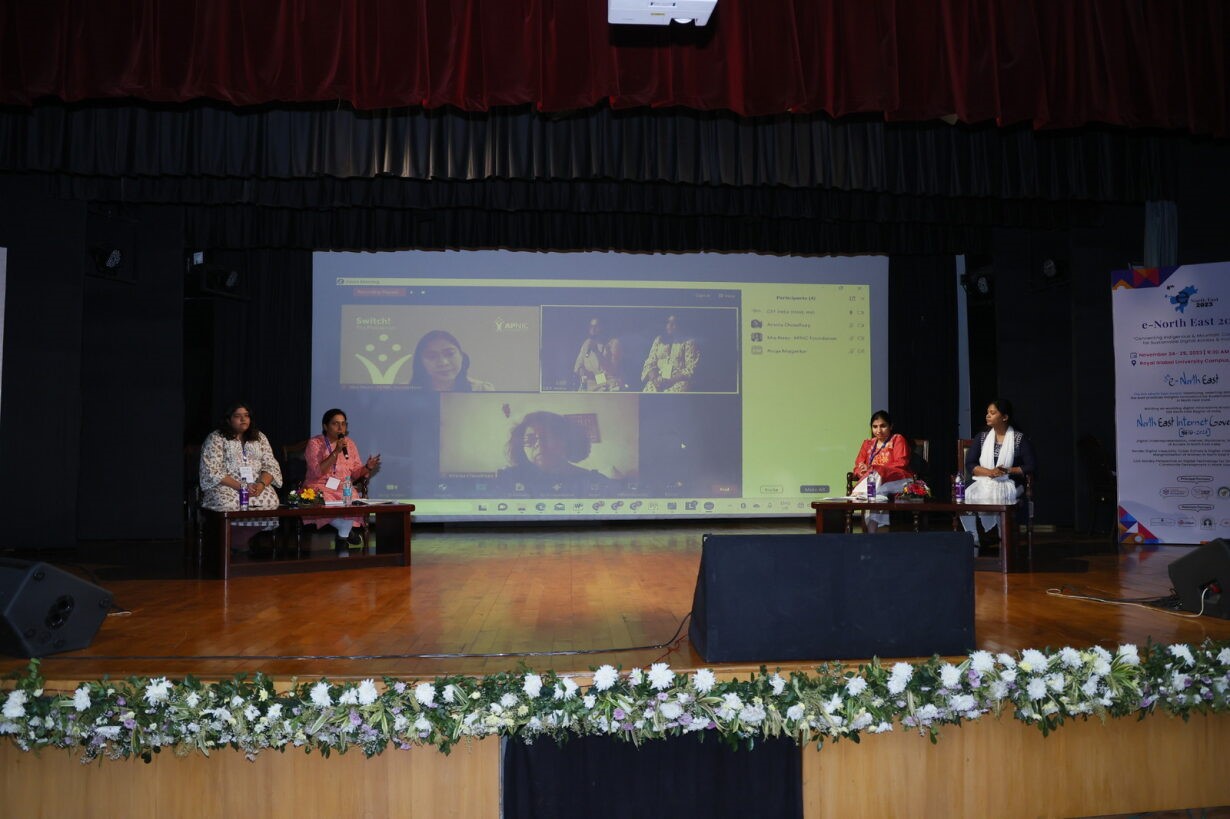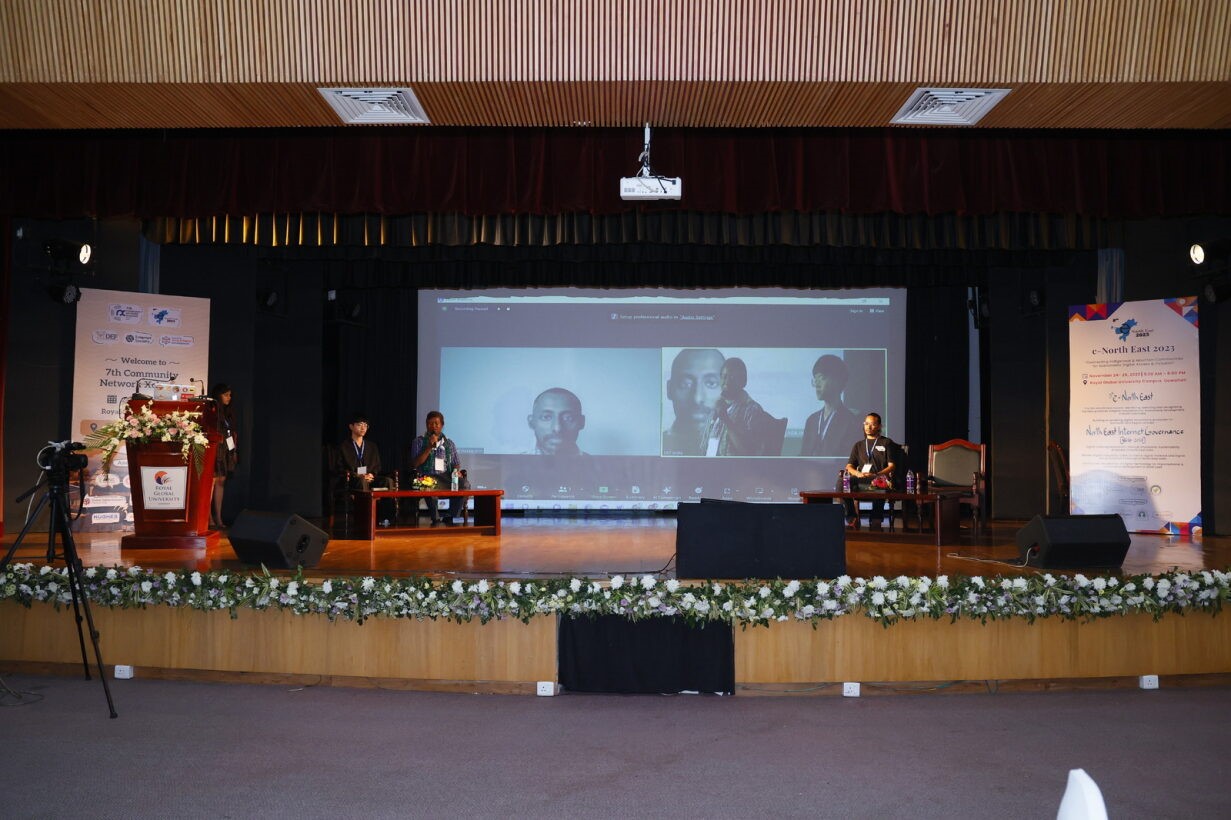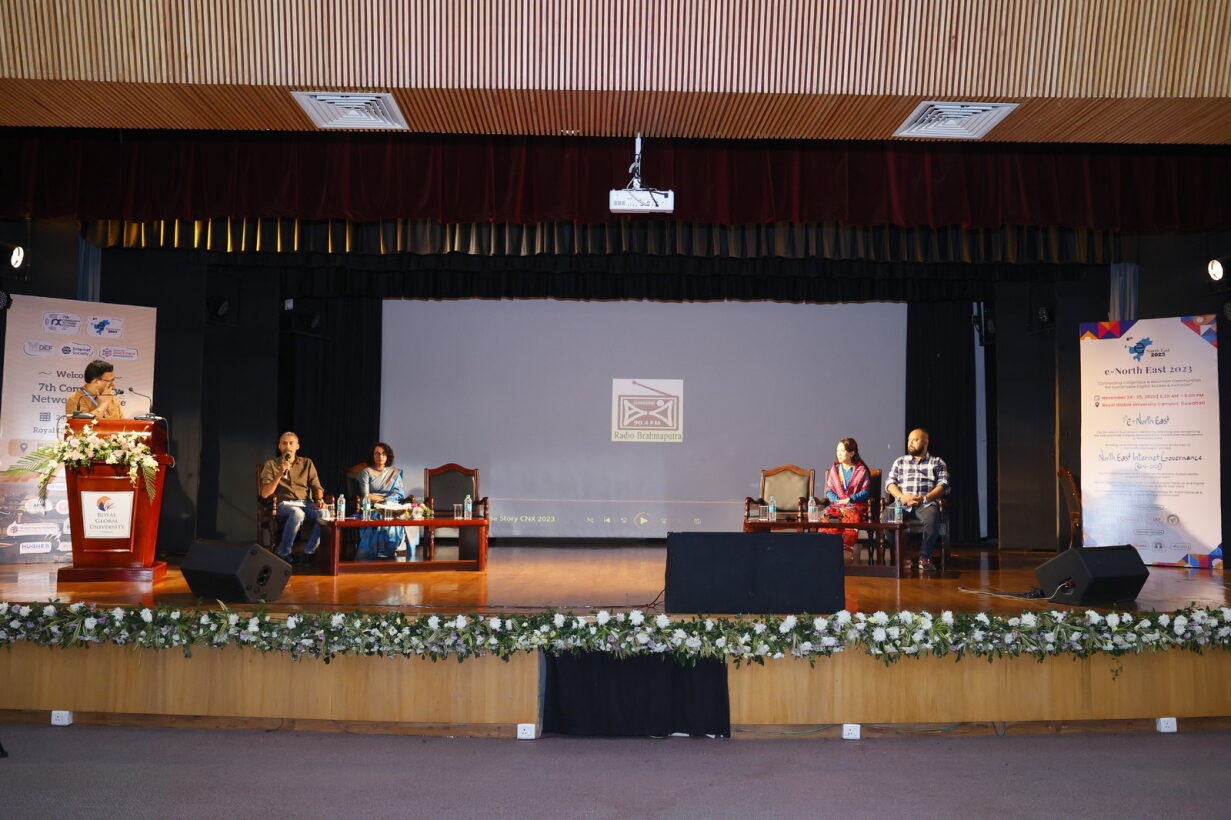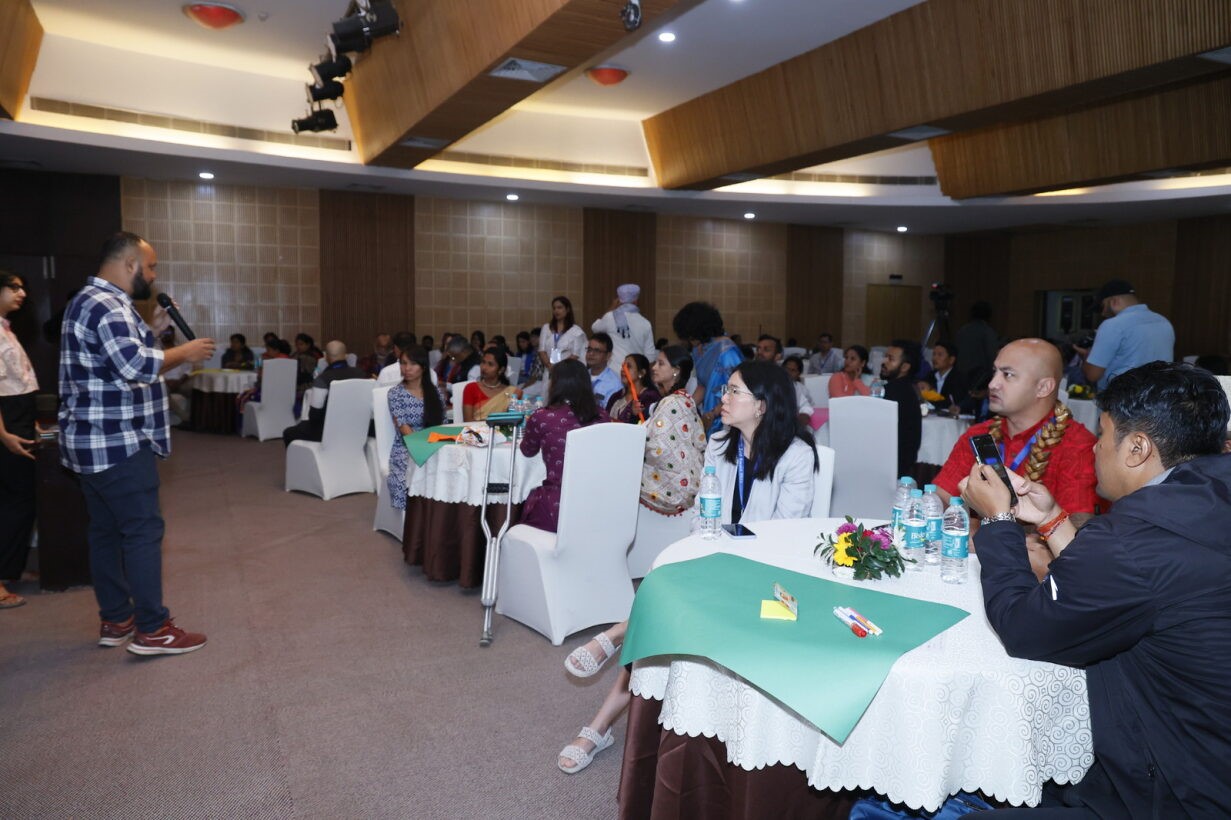Community Network Xchange (CNX) entered its seventh year in 2023. Community Network Xchange Asia Pacific was first organized in 2017, with a focus on bringing together community network practitioners and enthusiasts of community-driven Internet connectivity to exchange ideas and serve as catalysts for the grassroots connectivity movement. This year’s CNX was a collaborative effort by Digital Empowerment Foundation (DEF), Internet Society (ISOC), Council for Social & Digital Development in partnership with APNIC Foundation, Global Digital Inclusion Partnership, Royal Global University, Association for Progressive Communication, Hughes Communications India Private Limited, World Summit Awards, TATA Institute of Social Sciences Guwahati, Wireless for Communities and Art and Collective for Digital Empowerment (A-CODE).
The theme for the 7th edition of CNX in 2023 was Connecting Indigenous and Mountain Communities with a focus on the Asia Pacific region. It was a two day event that took place at Guwahati in Assam, one of the eight provinces/states in the North East Region of India. The event provided a platform for the stories of dedicated individuals contributing in improving digital connectivity in challenging geographical terrains and emphasized how their unwavering commitment and passion play a pivotal role in extending internet access to their respective communities.
Furthermore, CNX 2023 will focus on addressing last-mile accessibility, connectivity, and services for indigenous, tribal, hilly and mountain communities. The event will showcase the stories, challenges, and successes of diverse community networks from different parts of the world. Through these events, we intend to bridge the network divide in hilly, tribal, indigenous, and mountain communities and connect communities that have remained unconnected. This will involve promoting different variations of community networks, highlighting the role of women in community networks, and exploring the involvement of telecom service providers and ISPs in extending connectivity to the last mile.
Day 1: November 24, 2023
Inaugural Plenary Session – ‘Connecting the Indigenous & Mountain Communities towards Sustainable & Inclusive Digital Society in the Asia-Pacific’

The inaugural session of CNX brought together a diverse panel to discuss the challenges and opportunities surrounding access and connectivity in mountainous and hilly regions. Atsuko Okuda highlighted the importance of partnerships in achieving connectivity goals, while Sylvia Cadena addressed the challenges faced by organizations like APNIC Foundation. Bikram Shreshtha emphasized the role of civil society in connecting remote areas, citing his work in Nepal. Hasina Kharbih underscored the need for actionable government policies in India’s northeast. Dharmendra Singh called for telecommunications companies to revisit their policies, while Carlos Rey-Moreno advocated for alternative network systems driven by communities. Sasmita Samanta stressed the importance of community learning, and Akanksha Sharma discussed ITU’s efforts in mapping connectivity challenges. The panelists also discussed coordination, collaboration, and cooperation as essential elements in addressing connectivity issues. The session concluded with Osama Manzar highlighting positive developments, including ITU’s presence in Delhi and increased private sector interest in supporting community networks, emphasizing the importance of connectivity, capacity, and community in bridging the digital divide.
Technical Session 1: Panel Discussion – Access and Connectivity in Mountain and Hilly Regions: How Accessible is it today?

The panel discussion on “Access and Connectivity in Mountain and Hilly Regions” brought together a diverse group of experts to explore the current state of accessibility and connectivity in these challenging terrains. Here’s a summary of the key points discussed by each speaker:
- N Jairam from Hughes Communications India highlighted the difficulties faced in mountainous areas regarding technological availability and government services. He stressed the importance of proper power operations such as solar electricity and satellites for the adoption of sophisticated technology but acknowledged the challenges in accessing them, particularly in rural regions.
- Michael Ginguld of AirJaldi – Rural Broadband Pvt. Ltd, India, emphasized four critical elements for improving connectivity in remote areas: technical expertise, speed and stability of connections, sustainability, and affordability. He emphasized the need for proper planning and economic viability, citing the desire for internet speeds above 20 MBPS in India.
- Bikram Shrestha shared the success story of the Khunde Community Club in Nepal, which aimed to provide internet access to improve education in a region with limited resources. He highlighted the positive impacts of internet connectivity, including access to opportunities and marketing through social media platforms.
- Hasina Kharbhih, founder of Impulse NGO Network, discussed the link between internet outages and risky behavior leading to human trafficking. She also emphasized the role of internet access in promoting local artisans and sustainable living, particularly for indigenous women.
- BC Nayak, CTO of Reliance Jio, discussed the challenges of digitization and connectivity in hilly regions. He emphasized the importance of internet access for the younger generation and highlighted recent developments in extending connectivity to remote areas, including three districts in Assam. Nayak stressed the need for improved infrastructure and community collaboration to bridge the connectivity gap.
Overall, the panel highlighted the significance of internet access in mountainous and hilly regions for education, economic development, and community empowerment, while also acknowledging the challenges and the need for innovative solutions and government support.
Technical Session 2: Gender, Connectivity and Access: Role of Women in Community Networks

The second session of Community Networks Xchange focused on discussing the pivotal role of women in community networks. The session aimed to explore their contributions, challenges, and the potential of gender-inclusive connectivity to bring about transformative change. The panel featured speakers from various backgrounds, each offering unique insights into the intersection of gender, technology, and community development. Here’s a summary of the key points discussed by each speaker:
- Mia Perez from Switch in the Philippines emphasized the importance of empowering women and gender non-conforming individuals in community networks. She discussed Switch’s mission and efforts to address technical aspects, power supply concerns, and aligning objectives with APNIC. Mia is actively involved in research to enhance women’s involvement through affordable technical solutions, training, and certification.
- Isha Suri from the Centre for Internet and Society in India highlighted the need for women’s self-representation and advocacy to address their marginalization. She discussed the impact of gender restrictions on mobility, access to skills, and community involvement, emphasizing the importance of better-designed regulations and gender-aware policies for ensuring women’s access to public technological resources.
- Amrita Choudhury, Chair of AprIGF and Director of CCAOI stressed the significance of women’s representation considering their substantial portion of the global population. She discussed the value of networks and communities in empowering women, emphasizing their role in the modern world.
- Rajshree Joshi from BAIF Development Research Foundation highlighted the paradox of women’s significant use of social networks and technology alongside their vulnerability in online spaces. She shared an anecdote illustrating the importance of internet connectivity in generating employment, particularly during the pandemic.
Overall, the session provided a comprehensive exploration of the role of women in community networks, covering empowerment, representation, policy implications, and the transformative potential of gender-inclusive connectivity. The diverse perspectives offered by the speakers underscored the multifaceted nature of the challenges and opportunities in this domain.
Session 3: Presentations: Networking of Communities: Good Practices in Community Network Implementation from APAC Region-1

The presentations featured in this context cover a range of initiatives and projects aimed at enhancing connectivity and digital empowerment within various communities across Asia-Pacific regions.
- Model building of community networks by Gomer B Padong, Institute for Social Entrepreneurship in Asia (ISEA):
- Gomer Padong highlighted the efforts of ISEA in fostering knowledge creation and movement-building for social entrepreneurship in the Asia-Pacific region.
- Emphasized the importance of meaningful connectivity provided by ISEA, which has led to economic opportunities and inclusive growth, benefiting various sectors including businesses, schools, and hospitals.
- Mentioned the successful implementation of the DRS system and the use of vouchers for internet connectivity, facilitating seamless transitions for individuals relocating to new cities.
- Kacific next-generation in Asia Pacific, by Beatrice Mok, KACIFIC:
- Beatrice Mok discussed KACIFIC’s mission to provide high-quality satellite internet at an affordable price, focusing on meaningful connectivity.
- Highlighted the importance of selecting the best reseller, community marketing, and system flexibility to ensure effective distribution and awareness.
- Advocated for the utilization of private and public funds to make the infrastructure available, referencing the Information Society Innovation Fund (ISIF).
- tl (“network of hope”) by Ramon Roca, Naroman Esperansa, Timor-Leste:
- Ramon Roca discussed the importance of internet access in the lives of teachers and pupils in Timor-Leste.
- Emphasized the need for adaptive and long-lasting strategies for sustainability, focusing on technology’s usefulness and adaptability to local contexts.
- Bluewave Samoa district connectivity project, by Togisala Tony Sua Leota, BlueWave Wireless:
- Tony Sua Leota presented BlueWave Wireless’ initiative to provide community connectivity and digital literacy, particularly focusing on schools and women.
- Highlighted the importance of practical actions over theoretical notions in implementing internet connectivity services, striving to address community-specific problems effectively.
Overall, these presentations showcase diverse approaches and initiatives towards enhancing connectivity and digital empowerment in various communities, emphasizing the importance of adaptability, sustainability, and community engagement.
Session 4: Presentations: Networking of Communities: Good Practices in Community Network Implementation from APAC Region

This session was focused on initiatives and projects aimed at bridging the digital divide and improving internet connectivity and digital skills in rural and underserved communities. Here’s a breakdown of each presentation:
- The Prayuters Library by Nay Maneth:
- Maneth shares his personal experience and motivation behind founding the Prayuters Library.
- Focuses on providing access to e-books and digital literacy rather than physical books.
- Highlights the importance of ICT and digitalization in education, literacy, and connectivity.
- Better Access and Connectivity (BEACON) project, Philippines by John Garrity:
- Represents USAID/Philippines’ BEACON project.
- Emphasizes enhancing connectivity in remote and underserved areas through collaboration with the Department of Information and Communications Technology – Philippines.
- Discusses technical resources, community network models, sustainability, and scalability.
- Advocates for the adoption of innovative approaches and emerging satellite technologies to bridge the digital divide.
- Hello Hub, Nepal Community Network by Rabiraj Khadka:
- Presents the Hello Hub community network with 18 locations in Nepal.
- Demonstrates providing tablets with educational software and 24-hour Wi-Fi access for learning and recreational purposes.
- Services are provided free of charge to the community.
- Padma Shri Dhaniram, Toto Tribe:
- Dhaniram’s initiative focuses on preserving and promoting the Toto language and culture in the Totopara village.
- He recorded his voice to create a script for the Toto language, which previously had no script.
- Believes his actions can inspire others to retain their cultural traditions.
- Awarded Padma Shri in 2023 for his community work.
- Janata: Affordable Internet for the community by Mainul Hassan Alin, Bangladesh:
- Discusses affordability and mobility in internet access.
- Introduces Janata WiFi initiative in Bangladesh aimed at providing free and affordable internet.
- Mentions government initiatives like Smart Bangladesh Vision 2041 to improve internet accessibility.
- Talks about government funding and regulations regarding WiFi distribution.
Jenny Sulfath, from the Digital Empowerment Foundation, moderates the presentations. Overall, the presentations highlight various efforts and strategies to improve internet connectivity, digital literacy, and access to resources in rural and underserved communities.
Session 5: Policy & Regulation: Enabling Policy for Just Community Network & Meaningful Sustainable Connectivity & Access Last Mile

This session appears to be a panel discussion on the topic of community networks, internet connectivity, and related policies, particularly focusing on the Indian and Indonesian contexts.
Here’s a summary of the key points discussed by each speaker:
- Gustaff Harriman Iskandar (Director, Common Room Networks Foundation):
- Emphasized the importance of local skill-building for establishing community networks.
- Highlighted the lack of awareness among people in Indonesia regarding relevant policies and regulations.
- Advocated for the need for documentation and case studies to facilitate co-learning and the exchange of best practices.
- Isha Suri (Research Lead, Centre for Internet and Society, India):
- Shared insights from research, stating that community networks don’t have to adhere to rigid setups.
- Discussed challenges with the PM-WANI initiative in India, particularly regarding OTP authentication and the availability of backhaul.
- Advocated for relaxing licensing for service providers and emphasized the role of community networks in reaching commercially non-viable areas.
- Dharmendra Singh (Vice President – New Business, Hughes Communications, India:
- Stressed the need for recognizing internet connectivity as an essential service at the national level.
- Suggested a targeted approach for addressing connectivity gaps in India.
- Highlighted the potential of relaxed licensing policies for satellite operators to improve connectivity.
- Abhishek Raj (Centre for Internet and Society, India):
- Proposed including connectivity in the Gram Panchayat Plan to allocate funds for community networks.
- Identified challenges with PM-WANI and emphasized the need for backhaul infrastructure.
During the discussion, there were also insights shared regarding Indonesia’s experience with community networks and the role of government and telecom companies. Additionally, challenges related to infrastructure and connectivity gaps in areas served by Rail-tel were discussed.
The moderator, Osama Manzar, facilitated the discussion and asked questions about connectivity issues and policy innovations.
Day 2: November 25, 2023
Session 6: Presentations: Good Practices in Connectivity & Access in North Eastern Himalayan Region of India

This session outlines the speakers and their respective projects focused on community development, connectivity, and empowerment in various regions of India, particularly in Assam and Arunachal Pradesh. Here’s a summary of each project and speaker:
- Brahmaputra Community Radio Station by Bhaskar Bhuyan:
- Located in Dibrugarh, Assam, it’s the first community radio station in North East India.
- Aims to provide a platform for marginalized communities in isolated regions, broadcasting in local languages and dialects.
- The Ziro Valley Community Network Project by Nani Monya:
- Focuses on overcoming historical connectivity challenges in the remote Ziro Valley of Arunachal Pradesh.
- Introduced wifi in schools to provide connectivity and educational opportunities, particularly benefiting the Aratani tribes.
- The Char Chapori Networking Project by Manjuara Mulla:
- Operates in the Char Chapori region of Assam, empowering women through internet connectivity and entrepreneurial opportunities.
- Addresses gender-based discrimination and connectivity issues, mobilizing women to combat child marriages and advocating for digital solutions for education.
- Project Internet Roshni: Connecting the Tea Tribe & Adivasi in Assam by Austin Kawa:
- Aims to connect the historically marginalized tea tribe community in Assam through community networks.
- Provides digital services at low cost, prioritizing remote and backward societies, with plans to expand to other states.
- Collaborates with the state government to ensure digital inclusion and socio-economic upliftment.
These projects highlight the efforts to bridge the digital divide, empower marginalized communities, and promote socio-economic development through innovative initiatives and community-based approaches.
Session 7: Workshop: Building Community Network Capacity in local context for last mile internet access and reach; and Session 8: Community Networks (CNs) and digital initiatives in APAC region: A Mapping

In the workshop session, the attendees were asked to answer the following questions which are, What is a Community Network? What are the requirements of a Community Network along with the What makes a “network” a Community Network?
A community or a collection of people creates, owns, and runs a community network, which is a localised and decentralised communication infrastructure. It is intended to meet the unique requirements and preferences of the local community, frequently in places where conventional telecommunications infrastructure may be inadequate or non-existent. There are many different kinds of community networks, such as mesh networks, local Wi-Fi networks, and other kinds of connectivity options.
Regarding the Community Network’s requirements, the following significant points were covered in the submissions. Active participation and engagement of community people are crucial. The community should be involved in the network’s design, implementation, and upkeep. The hardware needed to build up a network, such as routers and access points, is referred to as networking equipment when discussing the infrastructure of the community network.
When a community or a collection of people who share a common interest or live close by creates, owns, and runs a network, it is referred to as a community network. A community network can be distinguished from conventional, for-profit networks by several essential features: The community it serves owns and runs a community network. Community members decide on issues about its creation, layout, and administration together. Community members actively participate in decision-making processes under decentralised, participatory governance arrangements.
At the end of the workshop session, the attendees were asked to create a utopian village of their choice; which resulted in a varied array of responses ranging from small community networks connecting a few institutions such as a local community, and school, to a few homes to a wide community network connecting one or two villages.


Leave feedback about this